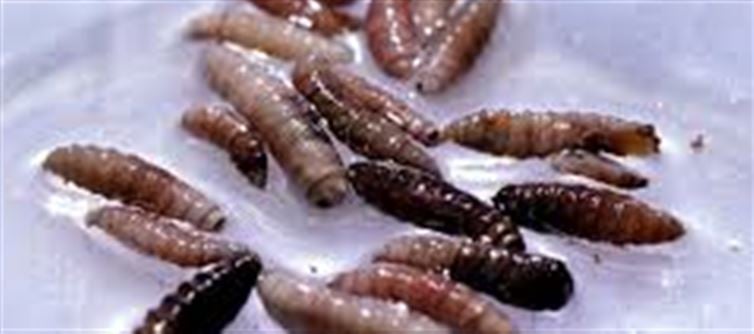
A concerning discovery has been made near the US-Mexico border, where the New World screwworm, a dangerous parasite, has resurfaced in northern Mexico. This species was previously eradicated in the United States, but its detection in this region has raised significant alarm.
Here’s everything you need to know about the New World screwworm, the risks it poses, and how to protect yourself and your livestock.
What is the New World Screwworm?
The New World screwworm is the larval form of a parasitic fly that is known to infest the wounds of mammals, including humans, livestock, and wildlife. The scientific name of this parasite is Cochliomyia hominivorax. Its larvae feed on the living tissue of their host, causing severe tissue damage and infections that can be fatal if left untreated.
While screwworm infestations in animals are more common, humans are also susceptible to the parasitic infection, particularly through open wounds or cuts.
Why is the Resurgence a Concern?
The New World screwworm was successfully eradicated from the U.S. in the late 20th century through extensive efforts, including the release of sterile male flies and chemical treatments. However, its detection near the US-Mexico border marks a significant setback in the fight against this deadly parasite. The reemergence of the screwworm could:
· Pose a threat to livestock: Cattle, sheep, goats, and other domestic animals could suffer severe injuries, leading to economic losses in agriculture.
· Endanger wildlife: The parasite poses a risk to native species, including endangered ones, especially in areas like national parks and wildlife reserves.
· Put humans at risk: While rare, screwworm larvae can infect humans if they come into contact with open wounds or cuts.
How Can You Stay Safe?
If you live near the border region or plan to travel to areas affected by this resurgence, here are some important safety measures you can follow:
1. Avoid Contact with Infected Animals
· Keep a safe distance from wild animals, livestock, and pets that may be carrying the screwworm larvae.
· Inspect livestock regularly for any signs of wound infestation, such as swelling, pus, or unusual behavior, and seek immediate veterinary help if needed.
2. Protect Your Wounds
· Clean and cover any open cuts or wounds to prevent the screwworm from accessing them. Make sure to use clean bandages and antiseptic solutions.
· Monitor for any unusual signs around wounds, such as pain, swelling, or discharge, and seek medical attention if you suspect infection.
3. Report Suspicious Activity
· Notify local authorities or health officials if you notice an animal with severe wounds or signs of screwworm infestation. Early detection is key to preventing further spread.
4. Stay Informed
· Follow local news and public health advisories to stay updated on areas affected by the screwworm. Officials will provide guidance on any measures to control the infestation, such as the release of sterile male flies or additional quarantine measures.
5. Work with Agricultural Experts
· Farmers and ranchers should consult with agricultural extension officers or veterinarians on preventive measures, including appropriate treatments for livestock and ways to manage the infestation in the region.
What Are the Symptoms of Screwworm Infestation?
For animals, the symptoms to watch out for include:
· Swollen or infected wounds, often with visible larvae (tiny, maggot-like creatures).
· Unusual behavior, such as restlessness or self-mutilation.
· Reduced feeding and weight loss.
For humans, symptoms of a screwworm infection may include:
· Pain and inflammation around the wound.
· Presence of larvae or maggot-like creatures.
· Fever, excessive swelling, or pus.
What’s Being Done to Control the Outbreak?
Efforts to control the reemergence of the New World screwworm near the US-Mexico border include:
· Surveillance and monitoring of affected areas, with special focus on wildlife and livestock.
· Sterilization programs: Like the previous eradication efforts, authorities may release sterile male flies to break the breeding cycle.
· Public awareness campaigns to educate the public about prevention, especially in rural areas.
Conclusion: Stay Vigilant
The return of the New World screwworm near the US-Mexico border is a stark reminder of the challenges involved in controlling zoonotic diseases and parasitic infestations. While the risk to humans is relatively low, it's important to stay informed, take preventive steps, and report any unusual signs of infestation in animals or people.
By taking these precautions and supporting local authorities’ efforts, we can help prevent the spread of this dangerous parasite and protect both human and animal health.
Disclaimer:
The views and opinions expressed in this article are those of the author and do not necessarily reflect the official policy or position of any agency, organization, employer, or company. All information provided is for general informational purposes only. While every effort has been made to ensure accuracy, we make no representations or warranties of any kind, express or implied, about the completeness, reliability, or suitability of the information contained herein. Readers are advised to verify facts and seek professional advice where necessary. Any reliance placed on such information is strictly at the reader’s own risk..jpg)




 click and follow Indiaherald WhatsApp channel
click and follow Indiaherald WhatsApp channel